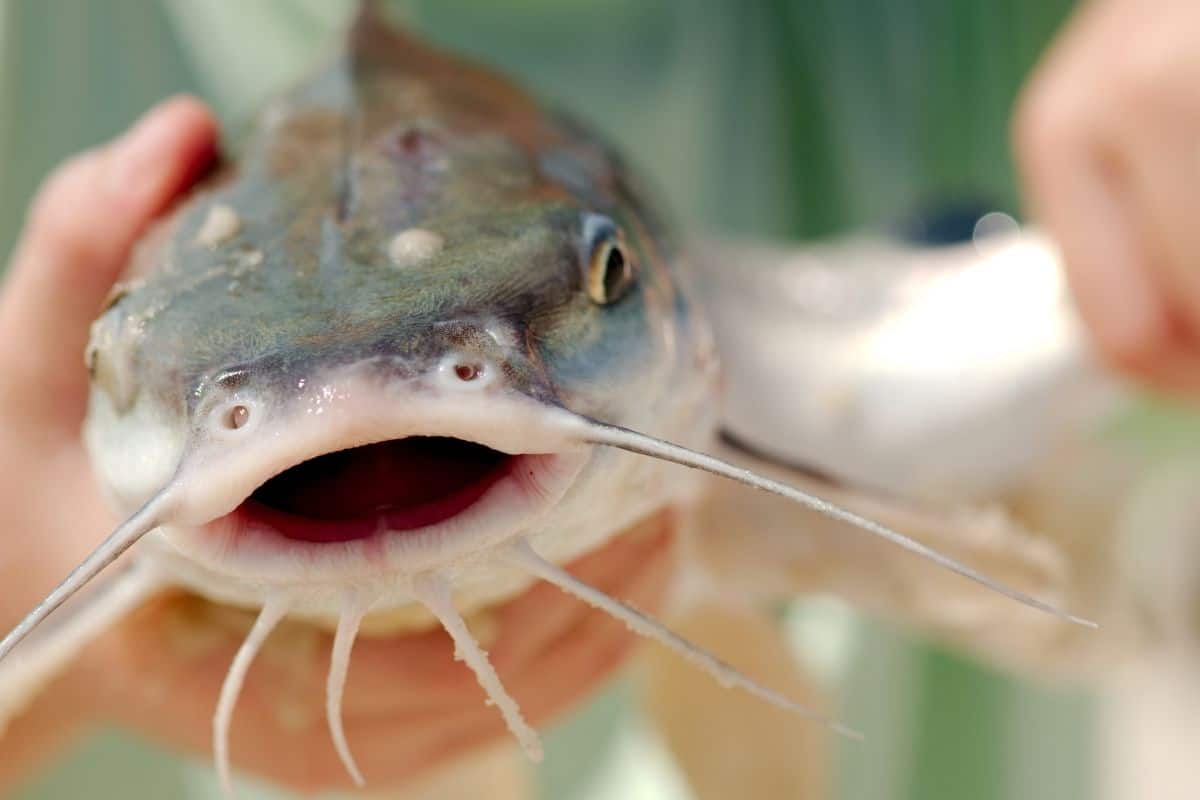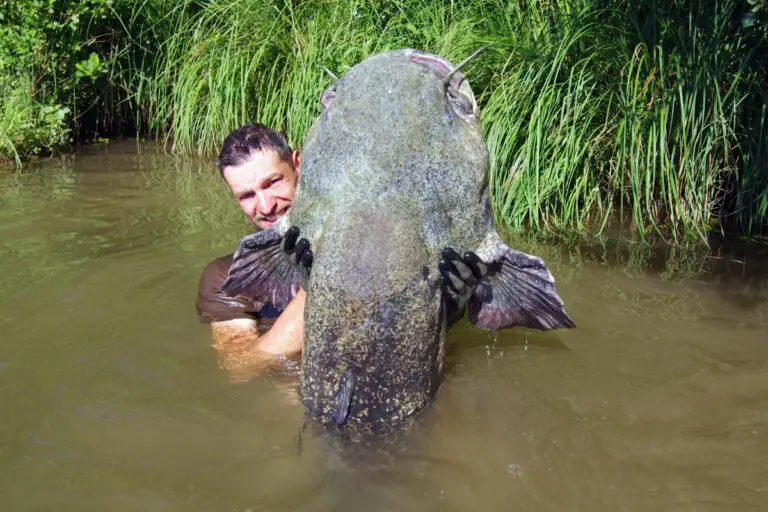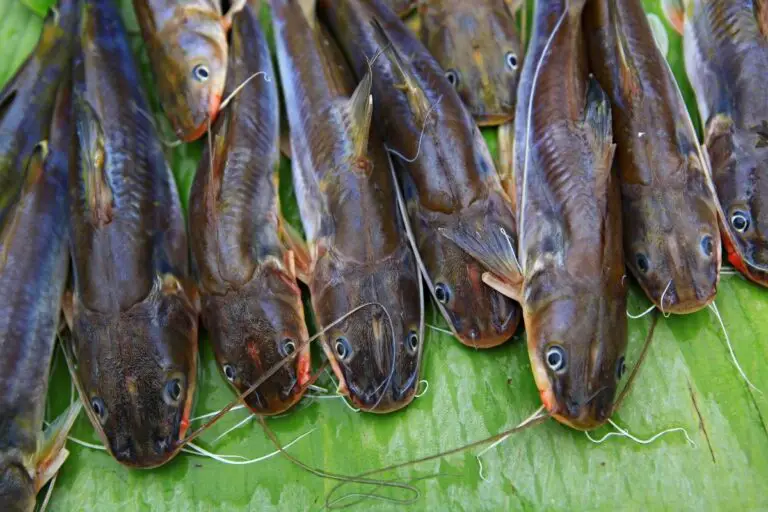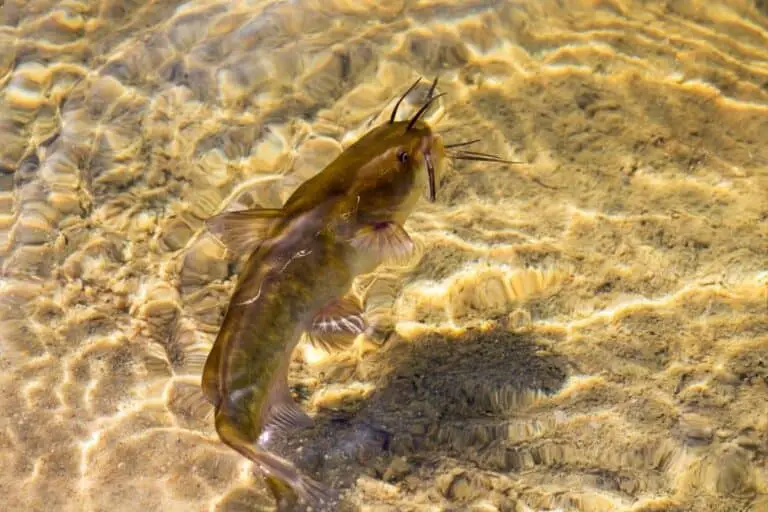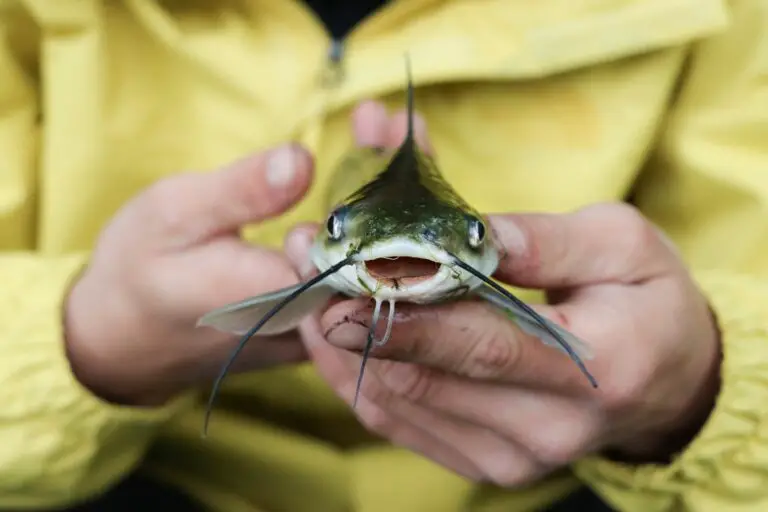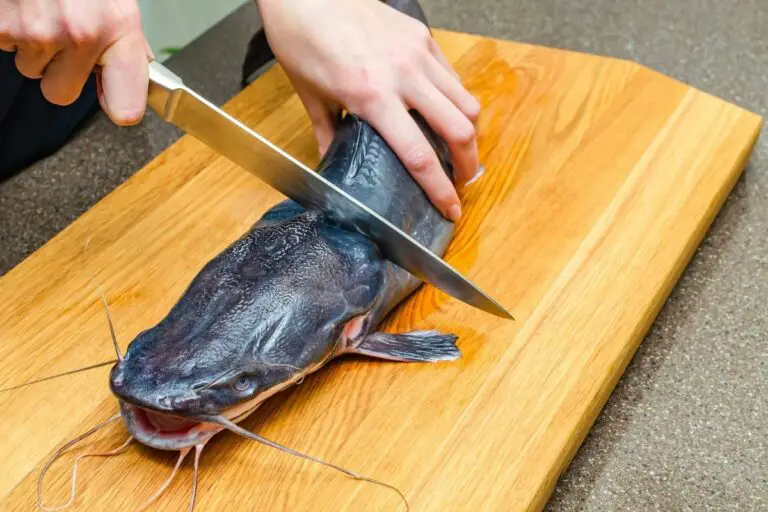Do Catfish Bite? A Safe Guide to Handling Catfish Without Stings
While catfish have uniquely shaped and useful teeth, they’re omnivores which means that they eat by sucking and gulping rather than use their teeth to bite or chew.
However, you still may have heard many reports of catfish attacks and stories about catfish biting people
So, do catfish bite? Catfish do not bite. That is because the anatomy of their teeth does not allow them to bite. They do not have sharp teeth, instead, they have small teeth that are angled inward, so it’s difficult for them to bite or cause serious injury even if you put your fingers into a catfish mouth.
Keep reading to learn more about catfish teeth and get some pro tips on how to hold the catfish to prevent any injuries or bites.
Table of Contents
Do Catfish Have Teeth?
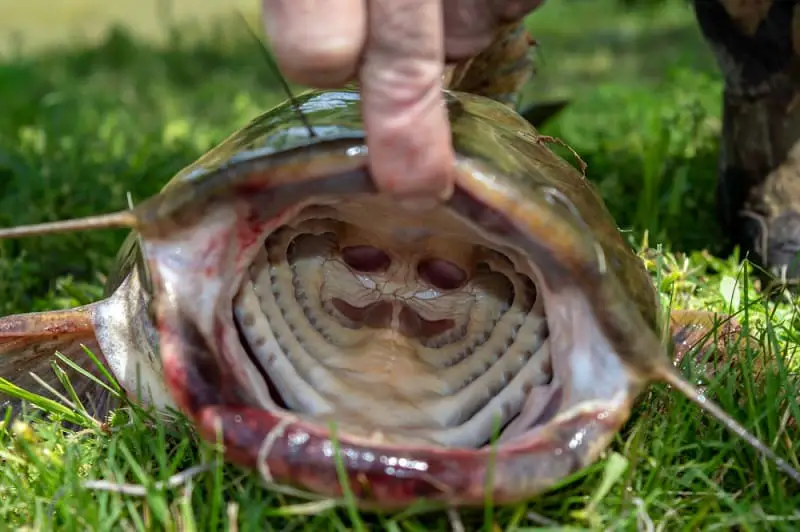
Yes, catfish have teeth, However, they don’t have strong, sharp teeth as the majority of large fish species. Catfish teeth are actually small, thick, and tilted inwards. Their teeth are also known to be abrasive and resemble the feeling of rough sandpaper to touch.
What Do Catfish Use Their Teeth for?
Catfish are omnivorous, which means that they can eat pretty much anything that comes their way. When they feed they mostly suck and gulp, rather than bite or chew their food.
So, they mostly rely on their teeth to prevent their prey from escaping. Since their teeth are angled inwards it allows the prey to easily get into the catfish mouth but it also makes it harder for it to get out.
Can A Catfish Bite Your Finger Off?
No, catfish cannot bite off your finger or cause any serious injury to you because their teeth are small and not strong enough to break the skin.
The way catfish teeth are shaped and angled inward also makes it practically impossible for them to bite even if you were to put your hand in the catfish’s mouth. However, it can be unpleasant to touch as it feels like coarse sandpaper and it may slightly scratch your skin
How to Deal with Bites If You’re Noodling for Catfish?
The main goal when you are noodling for catfish is to get your arm deep into the catfish’s mouth then pull the catfish from the water.
Catfish are strong fish and can put up a lot of fight. They’re capable of violent head jerks and can even pull you down into the water with them.
This makes noodling for catfish unpleasant despite the fact that catfish have small dull teeth. That is because having your bare skin scratch against the sandpapery teeth can easily leave marks, scars, and some skin abrasions if you are not careful.
In order to protect yourself from getting more scratches and scars, you can invest in a noodling sleeve. The purpose of these noodling sleeves is to cover your arm up to your elbow or shoulder (depending on which product is purchased) which will make it difficult for the catfish teeth to get directly in contact with your skin so that scratches and scars would be almost impossible.
Do Catfish bite swimmers?
No, catfish do not bite swimmers. There have been claims in October 2008 that a monster catfish called a Goonch was eating swimmers.
This fish is about 6 feet long and can be found in the Great Kali river, between India and Nepal where they often dispose of human bodies after Hindu funeral rites. However, these claims were never proved to be true.
Are There Other Claims of Catfish Attacks On Humans?
There are some reports over the years of giant catfish attacking and eating humans, however, these tales are almost always a myth.
There was a report in July 1998 of a boy getting mysteriously pulled underwater while his father was watching. An investigation was led by an angler named Jeremy Wade and broadcasted on a television show called River Monsters. Jeremy claimed that the incident is most likely a catfish attack, however, there was no way to confirm this claim as the body of the boy was never found.
There was another report in September 2007 of a giant catfish that was found in the Guangdong reservoir in China with human remains inside it. The catfish was said to be 10 feet long with a head that was more than 3 feet. However, this tale was actually made up.
I have a full guide on the real dangers of catfish to humans here that you should definitely check out.
Are catfish Aggressive?
No, catfish are not aggressive in their nature. Most of the time, catfish will just mind their own business. However, if they feel threatened, they can release the poison to defend themselves. While the catfish venom is not deadly to us, it can be lethal to other fish species.
Are Catfish Dangerous to Humans?
Yes, catfish can be dangerous to humans. That is because 1,250 species of catfish are venomous and most of these catfish species use their venom as a defense mechanism. Getting exposed to this venom is painful and can cause swelling along with a rapid increase of blood flow in the area of the injury.
You can learn how dangerous is touching a catfish here and how you can stay safe when handling Catfish.
Where Is the Catfish Venom Contained?
Catfish venom is contained in the sharp spines located on their pectoral and dorsal fins. The tips of the spines are very sharp, especially on smaller catfish. While it doesn’t hurt to touch them, it can be painful and dangerous if you accidentally puncture your skin on one of these venomous spines.
That is why it’s very important to clean the wound quickly and contact emergency services to avoid developing an infection or risk severe blood loss.
How to Correctly Hold a Catfish?

Catfish do not have scales as the majority of other fish species. So, handling them can be somewhat difficult because of how slippery they are.
You also need to be very careful about the spines in their fins, particularly with smaller catfish because their spines are sharper.
As the fish get bigger in size, their spines get much duller and the chances of being injured by them will be a lot less.
The best method to hold small catfish is to grip the fish from the top and keep your hand placed directly behind the pectoral and dorsal fins. Try to make sure you’re resting the area between your thumb and forefinger behind the dorsal spine.
This method is ideal with fish that are small enough for you to get your hand around them and keep a firm grip.
However, as the fish grow bigger, this method will become more difficult and you won’t be able to get your hand around them. So, the recommended method for handling bigger fish is using a “lip grip”.
Here is a simple video that illustrates this very well:
11 Tips to avoid getting bitten by a Catfish
Here are some useful tips that you can follow when handling a catfish to avoid getting bitten or injured:
- When you’re lifting the catfish, squeeze the fish’s body gently with your entire hand. You also need to make sure you’re applying equal pressure on all parts of the fish so it doesn’t slip out of your hand.
- Catfish will naturally extend their spines when they’re removed from the water, so make sure to keep the spines far away from your legs, pets, or children.
- Make sure to keep your grip very still and try not to let the catfish squirm much under your grip. Only make minor adjustments to your grip if it’s absolutely necessary because the more the fish moves around, the more likely you are to be bitten or injured.
- If the catfish is small, hold it by the line and grip its tail. Once you grip the tail, move your hand up carefully the body of the catfish until it’s positioned against the back of the pectoral spines.
- You can use your other hand for more support. That is because fully grown catfish can be very heavy so, positioning your hand on the tail section will make it a lot easier to lift heavier fish.
- Gripping the catfish with two hands will also allow you better control over a fresh catch if the fish begins to thrash around. It’s still important to keep your support hand far away from the sharp spines.
- You need to be cautious when you’re releasing the catfish back into the water. Try to lower the catfish as close to the water as possible then loosen your grip smoothly, while being careful not to let your hand brush along the fish’s back.
- Do not attempt to toss the catfish away from you, instead let it slip underneath the surface of the water so it can move on its own. Make sure to keep your fingers behind the spines and let the fish simply swim away harmlessly.
- Make sure to wear gloves to protect your hands. The durable material of rugged outdoor gloves will act as a barrier between the catfish spines and your skin.
- Consider investing in a lip grip tool. This tool will allow you to securely lift the fish by the lip then you can manipulate, inspect, and release it without even putting your hands directly on the fish.
- Make sure to bring basic first aid supplies including antiseptic spray and a topical hydrocortisone medication like Neosporin with you on the boat to treat any stings or bites caused.
If you are going to fishing for Catfish, you should also check out this guide to catching catfish in Muddy waters.
How to Safely Unhook a Catfish?
Here are the steps you need to follow to safely unhook a catfish without causing harm to the fish or yourself:
- After you reel in your catfish, pick it up by gripping behind the three frontal spines that are located on the edges of its dorsal and pectoral fins.
- If the catfish is too heavy to hold with just one hand, you can lay it on the ground or boat floor then prop its head up by picking it up by its gills or lipping it.
- If you are going to lip your catfish, it’s recommended to wear fishing gloves to avoid scratching your hand because the inside of their mouth is abrasive like sandpaper.
- Grab the fishing pliers with your free hand, then use them to grip the eye of the hook.
- After you get a good hold on the eye of the hook with your pliers, roll the hook’s eye towards the hook’s point. Then, as your hook starts to yank the fish’s mouth, twist the hook’s point and pull it out of the catfish’s lip.
You can also watch this video that illustrates how to unhook a catfish quite well:
What to Do If You Get Bitten by A Catfish?
If you get bitten by a catfish and start bleeding, you need to apply direct pressure on the wound using clean bandages.
If the scratch is minor, you can rinse the wound with fresh water, then apply antiseptic and dress the wound to help prevent any infection.
How to Treat a Catfish Sting?
The severity of the sting will mostly depend on where the spine punctured your skin, how deep the wound is, and if there’s any foreign matter is left in the wound.
Here are some tips you can follow to treat a catfish sting:
- Get out of the water and head to the shore. That’s because a catfish sting may cause nausea or make you feel lightheaded. So, it wouldn’t be safe to remain in the water.
- Avoid using ice on the wound. That is because the cold temperature will only make the toxins more powerful and the pain much worse.
- To reduce the pain, immerse the wound injury in hot water (as hot as you can tolerate). Within half an hour, you should begin to feel a significant reduction in pain and it will help flush out poison and germs from the wound.
- If any of the spines that punctured your skin broke off and were still in the wound, you need to remove them all using tweezers. Make sure not to leave any of the spines in the wound as they can lead to infection.
- The wound should be fully scrubbed and rinsed with fresh water. You can also clean out the wound using hydrogen peroxide if you are worried about any bacteria that might have gotten in.
- Cover the wound with clean bandages and keep it firmly wrapped to allow it to heal and remain clean.
- Monitor the injury closely and look out for any signs of infection. If you notice any swelling, redness, or tenderness around the area of the injury, it’s recommended to seek medical attention.
Outdoorskilled’s Recommended Gear for Superb Catfishing
I’ve testeI’vezens of reels, rods, and lines for Catfishing, and after years of testing, here are my quick picks that will definitely improve your current setup and results!
My recommended reel is the Abu Garcia Ambassadeur Reel C3-7000 which is ideally suited for catfish.

The rod I always recommend is the KastKing Perigee II Fishing Rod. It’s lightIt’sht, durable, and affordable. Furthermore, you’d haveyou’dde selection of models to choose from, whether you’re looyou’reor a spinning or casting rod. Lastly, it comes in twin-tips models, which means you’ll be you’llg two rods rather than one.

What I use is the Berkley Trilene Big Game Monofilament Fishing Line as it’s the sit’sgest, toughest mono I’ve ever I’veed and because it has exceptional shock strength, great knot integrity, tremendous abrasion resistance, and a high-visibility color option, you really can’t findcan’ter options

Related Questions
Do Wels Catfish Attack People?
Wels catfish have been reported to attack people and often taking them underwater to eat their remains. This monster catfish can grow up to 16 feet long and weighs up to 660 pounds. This catfish can mostly be found in southern, central, and Eastern Europe in lakes and slow-moving rivers.
How Big Can Catfish Grow?
Catfish can grow to reach nearly 700 pounds in weight. The size and weight of a catfish depend on the species and environment they can be found in. The three largest species of catfish are the Wels catfish, the Piraiba catfish, and the Mekong giant catfish.
Can You Get Injured When Holding a Large Catfish?
No, you can rarely get injured when holding a big catfish. You can easily handle them by scooping them up with a dip net and using lip grips for more control after landing them. Yet, it’s still important to be careful when you stick your hand in the mouth of a big catfish, as their mouths can sometimes be more dangerous than their fins.
Helpful Resources
Fishing for Catfish: The Complete Guide for Catching Big Channells, Blues and Flatheads
Resources for Catching Catfish Faster and More Easily
- Upgrade your gear with the best Catfish Rods here and the best Catfish Reels here
- You should also check out these perfect catfish rod and reel combinations here.
- Take your catfishing skills to the next level by checking this guide to catching Catfish
If you like this article, please share it or pin it, you can find the share buttons below. We will really appreciate it ❤️

